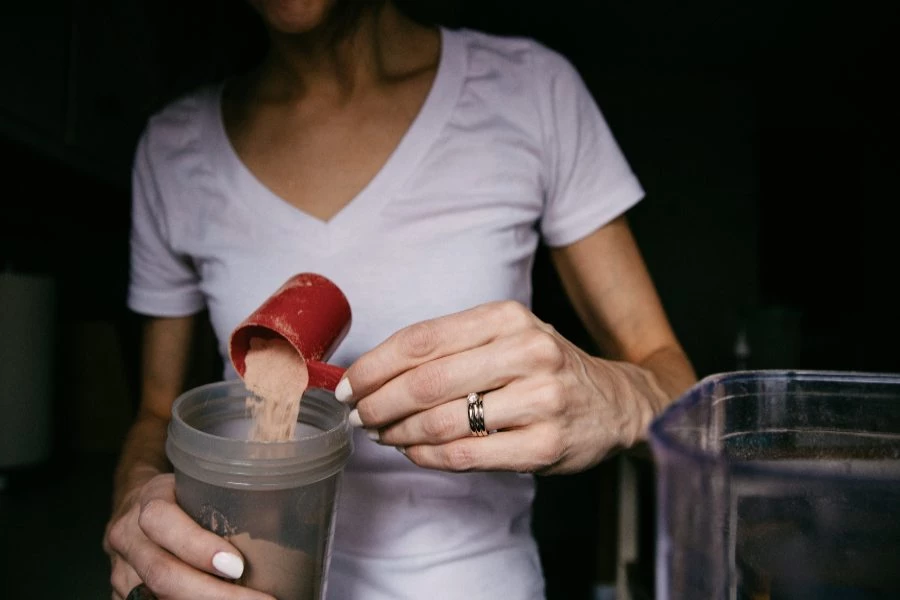Have you ever looked at the nutritional label on your protein powder and wondered how much one scoop is? You can measure one scoop of protein very easily! This blog post will demonstrate how to measure a single scoop of protein powder.
You’ll need a measuring cup and the scoop from your protein powder container. You must use the right type of scoop for your specific brand, though. If you’re unsure what size is best for you, consult with manufacturer directions.
How To Measure 1 Scoop Of Protein
Measuring out a “scoop” of protein can be frustrating. The only way to know how much protein you are getting is by using a scale. You can also use measuring cups, but the results may vary depending on what brand of the scoop (or cup) you own.
Using too little powder will result in more carbs coming through and make it harder to hit your macros; using too much will mean you’re wasting your powder and money.
It’s best to start using a food scale that measures grams. Weigh out your first scoop of protein and write down the weight. Then, use the same scale to measure each additional scoop until you have reached the desired amount. Be sure to zero out or tare the scale after each measurement.
This process may seem tedious at first, but it will become second nature once you get used to it. And, as with anything else, practice makes perfect.
What Is Protein Powder?
Protein powder is a dietary supplement that provides your body with essential amino acids to help muscle growth and recovery. You can mix it in water, milk, or juice for on-the-go convenience.
Protein powders come from whey protein concentrate/isolate, soy proteins, egg albumen (egg whites), rice proteins, and others. Most protein powders are not pure protein. They also often contain added vitamins and minerals.
Protein comes in many forms, including powder, liquid concentrate, or bars to eat on the go. Protein helps build lean muscle mass when combined with a workout routine. It is important to know how much of the scoop contains protein to calculate your daily intake of protein.
What Are The Benefits Of Consuming Protein Powder?
There are many benefits of taking protein powder. These include:
- Helping to build muscle mass: protein is the building block of muscles. When you are working out, your body breaks down protein into amino acids, which repair muscle tissue that has been broken down during exercise. Getting enough protein in your diet will help speed up this recovery process and allow for faster growth of new muscle cells when combined with a good workout program.
- Weight loss: protein powder can help you lose weight in two ways. First, it can help increase your metabolism because it takes more energy for the body to digest protein than other types of food. Second, high-quality protein powders are low in calories and fat but high in fiber, making them a good choice if you are trying to lose weight.
- Boosting the immune system: protein helps boost your immune system because it is responsible for transporting nutrients and oxygen throughout your body. When we don’t get enough protein, not only do we become fatigued, which lowers our energy levels, but we also aren’t able to fight off diseases as well, either.
- Improving cognitive function: studies have shown that people who eat high-quality protein are less likely to suffer from depression, Alzheimer’s disease, or dementia.
- Maintaining blood pressure levels: studies have shown that people on a low-protein diet are at an increased risk for developing hypertension (high blood pressure). Consuming enough protein in your diet will help lower the chances of developing hypertension.
- Source of amino acids: Protein powders are also a great source of essential amino acids, which the body cannot produce independently. Amino acids are the building blocks of protein, and they play a key role in many important processes, including cell growth and repair. Consuming adequate amounts of essential amino acids is important for overall health and well-being.
How Much Protein Should You Consume Per Day?
The recommended daily intake (RDI) of protein is 0.36 grams per pound. This means that the average person needs about 54 grams of protein per day. However, athletes and people trying to build muscle mass should consume more than the RDI.
A good rule of thumb is to eat 0.55-0.77 grams of protein per pound, which means that an athlete needs about 75-100 grams of protein per day, and someone trying to build muscle mass should consume about 125-180 grams per day.
How Can You Tell If You Are Getting Enough Protein?
There are a few ways to determine if you are getting enough protein in your diet:
Check the Nutrition Facts label on food packaging. The amount of protein is under the “Protein” heading.
Use a calculator to figure out your recommended daily intake of protein. Several online calculators will help you determine the amount of protein you need (and how much is in different types of food).
Use a tracking diary to write down everything eaten during the day and then check for any places where it looks like there might not be enough protein. For example, if you only ate one or two servings of meat or poultry that day, then you might not be getting enough protein.
Tips For Measuring A Scoop Of Protein Powder
- If you have a food scale, weigh the powder to ensure you’re getting an accurate measurement.
- Take into account how much power you’ll need for the recipe you’re making. Depending on the recipe, you may need more or less than one scoop.
- When measuring protein powder, be sure to use either a food scale or common kitchen measurements to get an accurate measurement.
- Depending on the recipe you’re following, you may need more or less than one scoop of protein powder.
- If you’re unsure how much to use, start with a smaller amount and add more as needed. You can always adjust the recipe later if needed.
- Protein powder is good for up to 12 months when stored in a cool, dry place and replaced once that time has elapsed.
- Remember to buy a protein powder with the same scoop size as your old container so you can continue to get an accurate measurement.
That’s it! Now you know how to measure one scoop of protein powder like a pro.
How Many Tablespoons Of Protein Powder Amount To 1 Scoop?
It depends on the type of protein. If you are using a scoop of about 30 grams, it will be approximately one tablespoon per serving size with most types of protein powder.
However, if you have a different brand or type of protein powder, use this method to measure your servings:
*Use a measuring cup to measure out the protein powder.
*Pour it into an even flat surface on your counter or food scale until you have reached one scoop.
*Mark where the level is with your finger or a permanent marker.
Since you now know how much one scoop of protein powder is, measure out that amount in tablespoons and write it down on an index card to take with you wherever you go.
Factors To Consider When Buying A Protein Powder
There are many different protein powders on the market, so it can be difficult to decide which one is right for you. Here are some things to consider when buying a protein powder.
* Protein Type:
There are two main types of proteins; whey and casein. With many variations within each type, the best choice is based on your preference for absorption rate and desired results from supplementation.
– Fast Absorbing Whey Proteins provide a quick burst of energy and are ideal for post-workout recovery.
– Slow Absorbing Casein Proteins digest more slowly and help keep you feeling fuller longer.
* Protein Concentration:
Protein concentration is the amount of protein in a given weight or powder volume. When looking at the nutrition label, this is ‘grams of protein per serving.’
* Protein Source:
Protein supplements are made from various sources, including whey, casein, and plant proteins. The source will determine how quickly you digest your supplement – so if you have a sensitive stomach, it’s best to stick to a protein source that works well with your body.
* Additional Ingredients:
There are a variety of other ingredients added to protein powders, including sugar, fat, and artificial flavors. These will determine the overall taste of your supplement, as well as whether or not you should avoid them (artificial sweeteners, for instance).
* Additional Additives:
Some supplements include additional additives like creatine, glutamine, and BCAA’s (branched-chain amino acids). These compounds can be beneficial for muscle growth and recovery. However, they are not part of the standard protein source.
* Flavors:
Protein powders come in various flavors, including chocolate, vanilla, and strawberry. If you’re on the lookout for something different, there are also various flavors available, including birthday cake, cookies and cream, and salted caramel.
Conclusion
You may have wondered how to measure 1 scoop of protein powder for a smoothie or other recipe. The answer is that there are many different ways you can do this, but the most accurate way would be by using a scale and weighing it out in grams on your kitchen countertop.
Remember, a scoop can be any volume measurement depending on what type of product or shake mix is being measured out. We hope our guide has helped clear things up!







